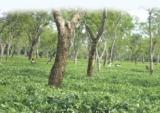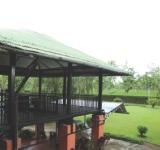IN THE LAP OF GREEN TEA PLANTS
 The beautiful landscape of the Assam tea gardens amidst the lush green rain forest make them unique in terms of tourist destinations. Yet there is no consorted effort from any quarter to boost the tourism in the state. Tourism in India is the largest service industry, with a contribution of 6.23% to the national GDP and 8.78% of the total employment in India. Majority of foreign tourists come from USA and UK. Maharashtra, Tamil Nadu, Delhi, Uttar Pradesh and Rajasthan are the top 5 places to receive inbound tourists. Domestic tourism is also massive in this country where Andhra Pradesh, Uttar Pradesh, Tamil Nadu and Maharashtra received the biggest share of these visitors.
The beautiful landscape of the Assam tea gardens amidst the lush green rain forest make them unique in terms of tourist destinations. Yet there is no consorted effort from any quarter to boost the tourism in the state. Tourism in India is the largest service industry, with a contribution of 6.23% to the national GDP and 8.78% of the total employment in India. Majority of foreign tourists come from USA and UK. Maharashtra, Tamil Nadu, Delhi, Uttar Pradesh and Rajasthan are the top 5 places to receive inbound tourists. Domestic tourism is also massive in this country where Andhra Pradesh, Uttar Pradesh, Tamil Nadu and Maharashtra received the biggest share of these visitors.
Tea tourism is becoming an ever-more fascinating idea as tea lovers and business people desire a more personal and in-depth experience of tea. Governments are adding tea tourism arms to their tourism bureaus. International conferences are including lectures and segments on tea tourism. Tea gardens - some of the most beautiful and serene places on earth - are setting up tourist lodgings. Tea tourism has the potential to be the most happening thing in Assam. Adventurous tourists are already frequently opting to visit luxuriant tea estates to relish gracious living amidst nature. For many Europeans it’s about tracing their roots, many of them throng in just to witness the reminiscence of the lifestyle lived by their forefathers.
 Apart from the historical link ups, the two other things which excite tourists are lush green tea gardens itself and the archaic Assam type tea bungalows. These bungalows in the Assam tea gardens are of a unique architecture. The British Geologist Richard Dixon Oldham, who was Director of Geological Survey of India can be called the pioneer of the Assam Type House. After the devastating earthquake of 1897, almost all the major buildings constructed by the British till that time in Assam were devastated. After thorough research, Richard Dixon designed what it is called the Assam Type House keeping in mind seismic vulnerability and other environmental factors.
Apart from the historical link ups, the two other things which excite tourists are lush green tea gardens itself and the archaic Assam type tea bungalows. These bungalows in the Assam tea gardens are of a unique architecture. The British Geologist Richard Dixon Oldham, who was Director of Geological Survey of India can be called the pioneer of the Assam Type House. After the devastating earthquake of 1897, almost all the major buildings constructed by the British till that time in Assam were devastated. After thorough research, Richard Dixon designed what it is called the Assam Type House keeping in mind seismic vulnerability and other environmental factors.
Jorhat is rightly called the tea capital of India; with lots of activities concerning the tea industry including the famous Tocklai Tea Research Laboratory- the place justifies the status. There are a whole lot of tea bungalows in and around Jorhat, a few of them even used by the state Government as office buildings or to house its officials instead of preserving and declaring them as heritage buildings. Jorhat is about 293 kilometers from Guwahati, the capital of Assam. It is connected by both Railways and Airways. There are direct flights from both Guwahati and Kolkata.
 Tocklai Experimental Station, Jorhat is the oldest and the largest research station of its kind in the world. Situated at the outskirts of Jorhat town, the Tocklai Experimental Station has five beautiful bungalows inside the campus all of which are heritage bungalows of the British period. The guest house at the Tocklai Experimental Station was built by Jorehaut Tea Co., the construction was started in 1920 and was commissioned in the year 1926 by a Chinese architect.
Tocklai Experimental Station, Jorhat is the oldest and the largest research station of its kind in the world. Situated at the outskirts of Jorhat town, the Tocklai Experimental Station has five beautiful bungalows inside the campus all of which are heritage bungalows of the British period. The guest house at the Tocklai Experimental Station was built by Jorehaut Tea Co., the construction was started in 1920 and was commissioned in the year 1926 by a Chinese architect.
The office of the Commissioner Upper Assam at Jorhat was actually a tea bungalow of the erstwhile Jorehaut Tea Co. The construction of the bungalow started in the year 1922 and was completed and commissioned in the year 1924. During those days it was occupied by the British Superintendent of Gardens.
In the good old days there used to be a swimming pool at the back yard of the bungalow, now it is deserted, abandoned and replaced by weeds. In the year 1961, when Price Philip, Duke of Edinburgh came to India, he visited Jorhat and stayed at this building to relive history. Unlike other Assam type tea bungalows this building is a concrete structure with a more gothic influence.
The famous Assamese tea planter Hemen Barua has three heritage tea bungalows with distinct Assamese features in the vicinity of Jorhat namely Thengal Manor, Bunyan Grove and Burra Sahib’s Bungalow.
| Governments are adding tea tourism arms to their tourism bureaus. International conferences are including lectures and segments on tea tourism. |
The Thengal Manor building will remain significant in the history of Assam because on 12th August 1935, the first daily newspaper in the Assamese language, ‘Dainik Batori’ was published from here. Situated in the most attractive part of the Gatoonga Tea Estate, the Banyan Grove is a bungalow which is about a hundred years old. The exterior is typical colonial with sprawling interiors of carpeted, wooden floors, verandahs with sloping roofs and a panoramic view of acres of flower-bedecked gardens. Burra Sahib bungalow is situated in Sangsua Tea Estate, this bungalow is known for its quaint colonial architecture and associated with the unique and graceful lifestyle of an age gone by.
These are only a few bungalows I have discussed in this write up and there are many more tea bungalows spread across the state; be it in the northern bank of the Brahmaputra or in the Barak Valley or the pristine locations of Dibrugarh and Tinsukia district - all of them equally beautiful and having value by way of heritage. Another interesting flavor to the tea tourism are the sprawling golf courses, there are at least 14 of these with 9 to 18 holes, maintained by different gymkhanas and tea companies.


